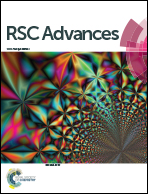A hydrophilic conjugate approach toward the design and synthesis of ursolic acid derivatives as potential antidiabetic agent†
Abstract
In this study, a series of novel ursolic acid (UA) derivatives were designed and synthesized successfully via conjugation of hydrophilic and polar groups at 3-OH and/or 17-COOH position. Molecular docking studies were carried out with the binding of UA and acabose in the active site of α-glucosidase, in order to prove that the hydrophilic/polar moieties can interact with the hydrophobic group of the catalytic pocket and form hydrogen bonds. The bioactivities of these synthesized compounds against α-glucosidase were determined in vitro. Kinetic studies were performed to determine the mechanism of inhibition by compounds 3, 4, 10 and 11. The results indicated that most of the target compounds have significant inhibitory activity, and the compound 3, 4, 10 and 11 were potent inhibitors of α-glucosidase, with the IC50 values of 0.149 ± 0.007, 0.223 ± 0.023, 0.466 ± 0.016 and 0.298 ± 0.021 μM, respectively. These compounds were more potent than parent compound and acarbose. The kinetic inhibition studies revealed that compound 3 and 4 were mix-type inhibitors while compound 10 and 11 were non-competitive inhibitors. Furthermore, the molecular docking studies for these two kinds of compounds suggested that free carboxylic group at either C-3 or C-28 position could remarkably improve inhibitory activity. It is noteworthy that the exploration of relationship between hydrophilic and polar groups of these structures and the hydrophobic group in catalytic pocket is benefited from our rational design of potent α-glucosidase inhibitor.


 Please wait while we load your content...
Please wait while we load your content...